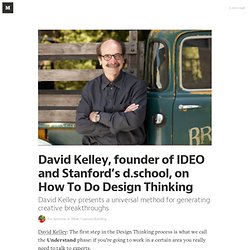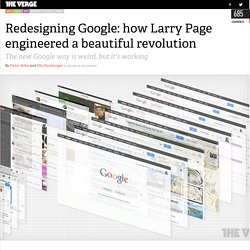

How To Do Design Thinking — What I Learned Building… David Kelley: The first step in the Design Thinking process is what we call the Understand phase: if you’re going to work in a certain area you really need to talk to experts.

We’re generalists, we’re expert at process but if you really want to do something, if you’re going to design a new medical device, you have to really immerse yourself in it. So in the first step you end up studying the state of the art, going and talking to experts, doing research to bring yourself up to speed. You’d be really surprised how quickly you can get up to speed, even in a highly technical area, just from doing a little research and talking to experts. They’ll tell you a lot more than you can use, more than you could ever imagine.
Then there’s the Observation phase. If we’re going to design a new gas station we’ll go and see how they pump gas in Japan. At some point by observing these people and building empathy for them you start to have insights about them. The next phase we call Visualize. InContext » SAP. Collaboration Joerg’s initial reading of the Contextual Design book led to a series of collaborations between SAP and InContext.

SAP and InContext have worked together on a number of projects including those listed below to introduce customer-centered design techniques into the skill set of those working in the company. “I see InContext’s core expertise as analyzing markets in depth and then deriving design implications from that analysis. The designs have a long-term effect and a general value and expertise in the process has a long-term effect.”
Joerg Beringer, SAP Delivering Results “For projects that address very innovative or new markets, we prefer InContext,” Joerg concludes. The Process Knowledge Transfer in Customer-Centered Design Intrigued by InContext’s book, Joerg took a Contextual Design course as an introduction to InContext’s approach to customer-centered design. Redesigning Google: how Larry Page engineered a beautiful revolution. By Dieter Bohn and Ellis Hamburger Something strange and remarkable started happening at Google immediately after Larry Page took full control as CEO in 2011: it started designing good-looking apps.

Great design is not something anybody has traditionally expected from Google. Infamously, the company used to focus on A/B testing tiny, incremental changes like 41 different shades of blue for links instead of trusting its designers to create and execute on an overall vision. The “design philosophy that lives or dies strictly by the sword of data” led its very first visual designer, Douglas Bowman, to leave in 2009.
More recently, however, it’s been impossible to ignore a series of thoughtfully designed apps — especially on iOS, a platform that doesn’t belong to Google. We went to Google looking for the person responsible for the new design direction, but the strange answer we got is that such a person doesn’t exist. They’re talking to each other. Sticky TOC engaged! Project Kennedy.
Diagrams. UX. Information Architecture. UX Indicators.